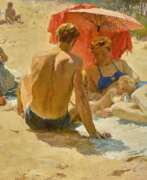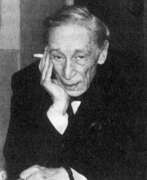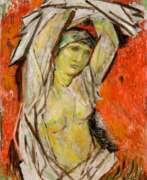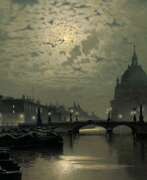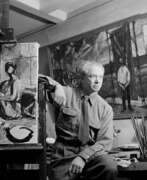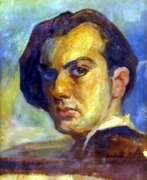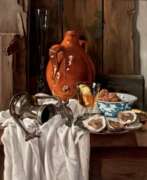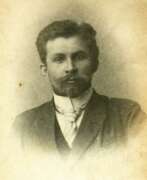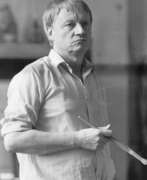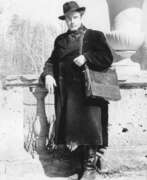Restorers 20th century


Paul Barthel was a German genre painter and portrait painter. He studied painting from 1877 at the School of Applied Arts in Dresden and then at the Royal Prussian Academy of Arts in Berlin with Julius Ehrentraut and Eugen Bracht.
Paul Barthel worked in Dresden, where he focused mainly on watercolours. In 1922 he settled in Bamberg, where he worked as a restorer.


Renata Boero is an Italian artist and restorer.
After completing her liberal arts education in Switzerland, she worked at the Palazzo Rosso Museum in Genoa. It was during the restoration of old tapestry canvases that Boero began to experiment with the use of natural substances in painting. She uses plant elements in her artworks and installations.


Henri Creuzevault was a French publisher, bookbinder and restorer.
In his youth he worked alongside his father, the bookbinder Louis Creuzevault. Together with him, Henri participated in an exhibition at the Musée Gallière in 1928 and received his first award, and in 1930 he became the owner of the workshop. In addition to bookbinding, he began publishing luxury books, commissioning illustrations from contemporary artists. Since then, he has been involved in both publishing and bookbinding at the same time.
At the 1937 International Exhibition, Henri Creuzevault won the First Prize for bookbinding. In 1946, he participated in the creation of the Original Bookbinding Society and took part in its exhibitions and in various book events in France and abroad. He also won a gold medal at the 1954 Milan Triennale. In 1937, the city authorities of Paris commissioned him to make bindings for gifts to the English princesses Elizabeth and Marguerite, as well as for the Golden Book of the Albert I Monument.
With his work, Henri Creuzevault created a new aesthetic concept oriented towards the freest expressions of the modern art of bookmaking.


Michel Favre is a Swiss painter and sculptor living and working in Martigny.
Michel trained as a marble sculptor from a young age: learning to work with materials, honing his craft and technical skills, and practicing restoration. In 1972 he opened his atelier in Martigny and until 1980 he created almost exclusively stone sculptures, but since the 1990s he has incorporated bronze, glass and other materials into his work. Since 1996 he has also created video installations, combining plastic arts, film, photography and new media. Michel Favre travels extensively and is passionate about archaeology.
The main motif of the sculptor's works is the fragile human being in a looming world of machines and technology. In his three-dimensional images, people are most often tiny and ant-like, trying to change something in the huge world around them.
Michel Favre has been a member of VISARTE (Society of Swiss Artists, Sculptors, Architects) since 1983 and has been active in numerous exhibitions around the world.


Igor Emmanuilovich Grabar (Russian: И́горь Эммануи́лович Граба́рь) was a distinguished Russian painter, art historian, and museum administrator, whose contributions have left an indelible mark on the world of art. Renowned for his versatility, Grabar was not only a masterful artist but also a visionary in art preservation and education. His work reflects a deep appreciation for Russia's cultural heritage, capturing the essence of its landscapes, historical moments, and architectural beauty with a unique blend of realism and impressionism.
Grabar's significance extends beyond his paintings; he played a pivotal role in the preservation of Russian art, overseeing restoration projects and establishing guidelines that are still in use today. His efforts in cataloging and promoting Russian art helped to elevate the profile of Russian culture on the global stage. Among his well-known works, "February Azure" stands out for its captivating use of color and light, showcasing Grabar's skill in conveying the beauty of Russian winters.
As an educator and museum director, Grabar influenced generations of artists and art historians, embedding a deep respect for artistic heritage and innovation. His leadership at the Tretyakov Gallery and involvement in various art schools helped to shape the direction of Russian art in the 20th century. Grabar's legacy is not just in his artworks but also in his contributions to art education and museum practices, making him a revered figure among collectors, experts, and enthusiasts of art and antiques.
For those passionate about the rich tapestry of Russian art and culture, Igor Emmanuilovich Grabar's work remains a source of inspiration and admiration. We invite collectors and art experts to sign up for updates on new product sales and auction events related to Grabar's work. This subscription is your gateway to the world of a visionary artist whose influence continues to resonate in the art world.


Nikolai Mikhailovich Gushchin (Russian: Николай Михайлович Гущин) was a Russian and Soviet artist, celebrated for his portraits, landscapes, and still lifes. His journey through art and life spanned continents and eras, marked by both acclaim and adversity. Gushchin's formative years were enriched by academic training, leading to early works that showcased his talent through pencil drawings like "Portrait of mother" and "portrait of a nephew of Victor". His evolution as an artist is noted for a transition from Impressionism to incorporating elements of Cubism and Futurism, demonstrating a vibrant exploration of modern art movements.
Gushchin's career took a pivotal turn during his years in exile from 1919 to 1947, a period that saw him achieve recognition across Europe. He became a member of the expert council of the Louvre, and his works were acquired by museums in Paris, Grenoble, Monte Carlo, and Nice. His style during these years melded Art Nouveau, Symbolism, Expressionism, and Fauvism into a distinctive mode of expression. Despite his success abroad, Gushchin's return to the Soviet Union in 1947 brought challenges, including the ideological ostracism that limited his opportunities to teach and exhibit his work.
Gushchin's legacy includes a significant body of work that remains influential. His paintings and drawings, characterized by expressive color and dynamic compositions, are held in high regard both in Russia and internationally. The Radishchev Museum boasts the largest collection of his works, illustrating the breadth of his talent and the diversity of his subjects.
For collectors and experts in art and antiques, Gushchin's oeuvre offers a fascinating glimpse into the intersection of individual creativity and historical tumult. His works not only embody the stylistic shifts of the 20th century but also reflect the personal resilience and artistic integrity of their creator.
To stay informed about sales and auction events featuring Nikolai Mikhailovich Gushchin's work, sign up for updates. This subscription will ensure you're the first to know about opportunities to acquire pieces by this remarkable artist.


Tom Hartwig is an Austrian artist and restorer.
He trained as an art restorer in Salzburg, where he also met famous artists. Since 1974 he has worked in Germany, including as an art restorer, but he has become increasingly fascinated by painting.
Tom Hartwig's world is colorful and strange; he creates powerful, large-format works, which he often frames as diptychs or triptychs. He is fascinated by the processes of nature and its power, especially "creative destruction. A volcanic eruption preparing the earth for a new life, a planetary explosion resulting in the formation of thousands of stars are the main subjects of the artist.


Konrad Honold was a painter, restorer, graphic artist, and heraldist. He began his artistic career at a young age, apprenticing in a painting workshop in Ravensburg. He furthered his training at Toni Kirchmayr's art school in Innsbruck and the Academy of Fine Arts in Berlin. Honold settled in Schruns, Austria, where he worked as a painter and restorer. His works included panel paintings and designs for various mural techniques, focusing mainly on sacred art. He also contributed to the preservation and restoration of church spaces, continuing the tradition of church painting. Honold was involved in heraldry, creating coat of arms for the Vorarlberg State Government and various municipalities in the region. He was an active member of the Montafon Heritage Association and played a crucial role in establishing the Montafon Heritage Museum in its current location.


Andrzej Irzykowski is a Polish painter, sculptor and restorer living and working in Germany.
Andrzej studied at the Academy of Fine Arts in Gdansk after an apprenticeship as a mason in conservation workshops. As a freelance artist, Andrzej Irzykowski has been living and working in Germany for over 30 years.
The fusion of figurative and abstract forms has become a hallmark of Andrzej Irzykowski's work. One of his most recent exhibitions was entitled "Heads" - anthropomorphic sculptures in realist, surrealist and abstract expression. Irzykowski has exhibited his work in numerous solo and group exhibitions at home and abroad and has received many prizes and awards.


Icilio Federico Joni was an Italian artist known for his exceptional talent in producing forgeries, particularly of Quattrocento paintings. Born in Siena in 1866, Joni's career in art forgery began in a gilding shop, where he honed his skills with wood, plaster, and paint. His forgeries were so convincing that they made their way into renowned collections and questioned the boundaries between counterfeit and creative artistry.
Icilio Federico Joni's works include not only paintings but also forged book covers, imitating the historic Biccherne covers from Siena. His creations, like the Madonna with Child, Saint Mary Magdalene, and Saint Sebastian, showcase his profound ability to adopt and adapt the styles of historic Sienese painters like Neroccio di Bartolomeo and Matteo di Giovanni, infusing them with his own interpretations and variations.
Despite the initial secrecy surrounding his forgeries, Icilio Federico Joni's desire for recognition led him to openly discuss his deceptions in his autobiography. His techniques in aging his creations were so meticulous that they often confused even expert art historians, adding a layer of complexity to the debate over his legacy as either a master forger or a creative genius in his own right.
Joni's story is not just a tale of deception but also a commentary on the art market's vulnerabilities and the thin lines between imitation, inspiration, and fraud. For art collectors and experts, his life and works serve as a fascinating study in the dynamics of authenticity and value in the art world.
For those intrigued by the enigmatic world of art forgeries and the exceptional craftsmanship of Icilio Federico Joni, we invite you to sign up for updates. By subscribing, you'll receive notifications about new discoveries, exhibitions, sales, and auction events related to Joni's works and the fascinating realm of art history. Stay informed and delve deeper into the intriguing stories of art and authenticity.


Nida Kadhim is an Iraqi sculptor, noted for producing a number of monumental works for Baghdad's city centre, some of which are still standing, while others were demolished or looted following the 2003 Iraqi invasion. Kadhim received his formal art education at Baghdad's Academy of Fine Arts in the 1950s. Actively involved in the Iraqi arts community, he became a founding member of the art group known as Al-Mujadidin (The Innovationists). His sculptures focus on grandiose busts and statues of leading figures taken from Iraq's history, or are based on other themes the artist considers worthy. His most well-known sculpture, which is still standing, is the Arab Woman in Zawra Park, Baghdad. It depicts an Arab woman holding a bouquet of flowers out to the new generation of Iraqis who are seeking a better future.
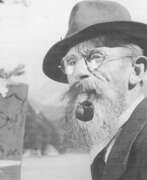

Toni Kirchmayr was an Austrian painter and restorer. He received his first artistic training from the native painter and poet Alfons Siber. He then took lessons in ornamental and fresco painting from the fresco painter Rafael Thaler in Innsbruck until 1903 and completed a further year at the private painting school Moritz Weinhold in Munich. On 1905 he started studying at the Academy of Fine Arts in Munich. He was headmaster of the Heymann painting school, did decorative and decorative arts painting for publishers and worked as an assistant to church painters and restorers in the summer, which gave him knowledge of fresco painting. He had to interrupt his studies in 1908/1909 for military service. After completing his studies in 1910, he settled in Innsbruck as a freelance artist. Shortly after the end of the First World War, in January 1919, he founded the Toni Kirchmayr School of Painting and Drawing in Innsbruck, which existed until his death and became the most important artistic training centre in Tyrol. Toni Kirchmayr created a versatile oeuvre ranging from landscapes, interiors and still lifes in oil to ornamentation and decorative art and large-format wall and ceiling frescoes. The landscape painting shows modern, colour-expressive features. Kirchmayr showed a special talent as a portraitist.


Serge Kislakoff was a French artist and decorator of Russian origin. He is the author of numerous film posters.
Serge Kislakoff painted city views and scenes (Montmartre, Paris boulevards, carnivals in Nice and Cannes), landscapes, harbour views (south of France, Sweden), religious subjects inspired by Old Russian painting. He was also involved in the restoration of church paintings.
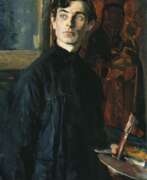

Pavel Dmitriyevich Korin (Russian: Павел Дмитриевич Корин) was a distinguished Russian painter and art restorer, celebrated for his contributions to Soviet art and his unfinished masterpiece, "Farewell to Rus." Born in 1892 in Palekh, a village renowned for its icon painters, Korin was destined for artistic greatness, following in the footsteps of his father, a professional icon painter. His education in iconography at Palekh and later training under prominent artists such as Mikhail Nesterov and Konstantin Korovin at the Moscow School of Painting, Sculpture, and Architecture shaped his artistic vision and technique.
Korin's career was marked by his exceptional ability to blend traditional Russian art forms with contemporary themes. His notable works include portraits of Soviet intelligentsia and frescoes that adorn the Moscow Metro stations and the Moscow Kremlin. Korin's dedication to his craft earned him numerous awards, including the Stalin Prize and the Lenin Prize, affirming his status as a master of Soviet art.
The artist's magnum opus, "Farewell to Rus," was inspired by the funeral of Patriarch Tikhon and aimed to depict the lost essence of Russia post-October Revolution. Despite four decades of preparatory work, including detailed studies and a life-sized copy of Alexander Ivanov's "The Appearance of Christ before the People," Korin never commenced the final painting. His painstaking preparation and dedication to this project, however, underscored his profound connection to Russian history and orthodoxy.
Korin's legacy extends beyond his paintings; he is remembered for his efforts to preserve Russian artistic and religious heritage, including saving the prized icons and frescoes of the Convent of Martha and Mary from destruction. His death in 1967 was mourned by both the clergy and laity, and his contributions continue to be celebrated in exhibitions and the collections he helped preserve.
For art collectors and experts, Korin's work represents a unique blend of traditional and modern, encapsulating the tumultuous history and cultural heritage of Russia. To stay updated on sales and auction events related to Pavel Dmitriyevich Korin, signing up for updates is highly recommended. This ensures exclusive access to valuable insights and opportunities to acquire works by one of Russia's most revered artists.


Lodovico Pogliaghi is an Italian painter, sculptor and decorator. He studied at the Brera Academy under Giuseppe Bertini.
As a leading representative of eclectic academism, focused on restoring earlier classical styles, Lodovico Pogliaghi devoted himself intensively as a consultant to the Department of Antiquities and as a restorer.


Paolo Salvati was an Italian expressionist painter and restorer.
After training as a surveying engineer, Salvati developed a passion for painting, particularly expressionism. He worked with pastels and tempera, did oil painting, and painted in acrylics. His works include landscape miniatures, seascapes, still lifes and portraits. Salvati's works are characterized by life-affirming, saturated colors.
Salvati also designed and restored stringed instruments.


Alfons Siber, an Austrian painter and restorer, began his artistic journey as an apprentice at the Tiroler Glasmalerei-Anstalt in Innsbruck. He studied at the Academy of Fine Arts in Vienna and received several awards and scholarships. Siber settled in Hall in Tirol, where he worked as a painter and restorer. He founded the Tiroler Künstlerbund and created numerous portraits, landscapes, and large-scale church murals. Siber also carried out restoration projects.


Ernst Steinacker is a German sculptor and restorer.
He was educated at the Stuttgart State Academy of Fine Arts and created his own works in bronze, stone and wood.
For five years, Steinacker restored Spielberg Castle on his own and turned it into a museum and cultural center. His workshop was also located there.


Klaus von Woyski was a German painter, graphic artist and restorer.
Von Woyski joined the Verband Bildender Künstler Kassel (Association of Visual Artists Kassel) and turned to non-objective painting at this time, numerous participations in exhibitions followed.
Since the entire family moved to Greece in 1970, Klaus von Woyski's painting style changed back to realism due to the new impressions of the landscape and the Greek light.


Stepan Petrovich Yaremich (Russian: Степан Петрович Яремич) was a multifaceted Ukrainian artist and art historian, whose career spanned the late 19th and early 20th centuries. His profound contributions to art history and preservation, particularly during the tumultuous post-revolutionary period in Russia, underscore his significance beyond his work as a painter. Yaremich's expertise in Western European drawing, bolstered by his years in Paris where he amassed an impressive collection featuring masters like Watteau and Fragonard, highlighted his remarkable connoisseurship.
Educated in Kiev and Paris, Yaremich was associated with the "World of Art" movement and worked closely with figures like Alexandre Benois. He was not just an artist but a respected art expert, often involved in the restoration and cataloging of Russian and Western European art. His time at the Hermitage and Russian Museum showcased his dedication to art preservation, contributing significantly to the fields of art history and conservation.
Yaremich's artistic legacy includes landscapes of St. Petersburg, Venice, and other locales, characterized by a unique approach to color and form that distinguished his work from his contemporaries. Despite the critical acclaim, it was his behind-the-scenes work as an art historian and conservator that solidified his enduring impact on the art world.
Collectors and experts in art and antiques will find Yaremich's work both compelling and significant, underlining the importance of not only creating art but also preserving it for future generations. For updates related to Stepan Petrovich Yaremich, including sales and auction events, sign up for our newsletter. This subscription will keep you informed about the latest findings and opportunities to acquire works associated with this remarkable figure in art history.
















